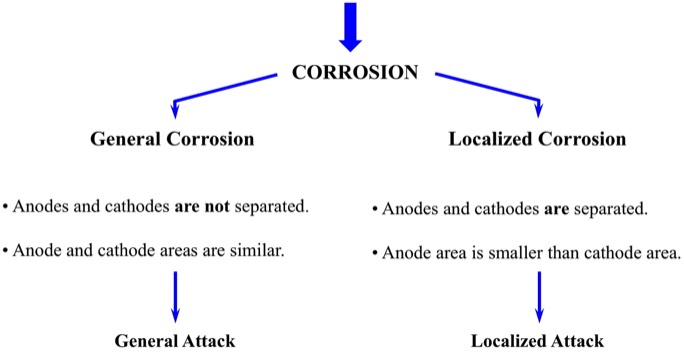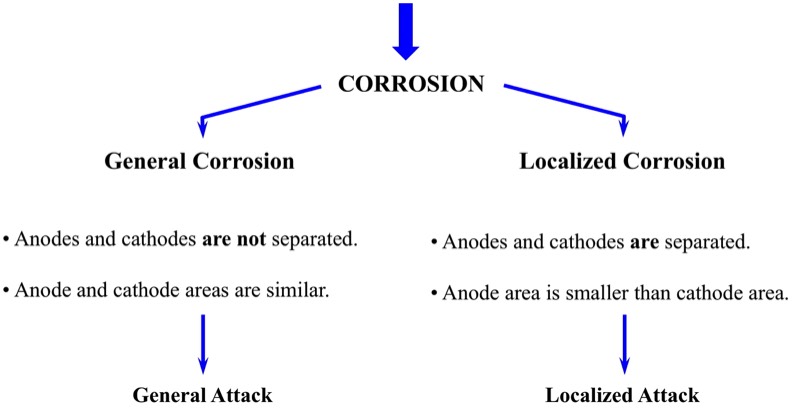Currently viewing
Menu
Forms of Corrosion - Introduction
The Forms of Corrosion are divided into two broad categories: General Corrosion and Localized Corrosion.
Localized Corrosion is divided into many sub-categories.
Atmospheric Corrosion is not always listed as a "form of corrosion", but is included here because it represents a major environment in which corrosion may occur.
As presented in the Diagram below, individual anodes and cathodes do not become stabilized at specific sites during General Corrosion. A cycle is established in which anodes become cathodes - and then revert back to being anodes again. In general, the areas of anodic sites and cathodic sites are similar.
In the case of Localized Corrosion, anodes and cathodes are separated and become established in specific areas. Anodic areas tend to be small - relative to cathodic areas. Even though the loss of metal or alloy at an anodic site may be small, the anodic current density and rate of penetration can be high.
Localized Corrosion is divided into many sub-categories.
Atmospheric Corrosion is not always listed as a "form of corrosion", but is included here because it represents a major environment in which corrosion may occur.
As presented in the Diagram below, individual anodes and cathodes do not become stabilized at specific sites during General Corrosion. A cycle is established in which anodes become cathodes - and then revert back to being anodes again. In general, the areas of anodic sites and cathodic sites are similar.
In the case of Localized Corrosion, anodes and cathodes are separated and become established in specific areas. Anodic areas tend to be small - relative to cathodic areas. Even though the loss of metal or alloy at an anodic site may be small, the anodic current density and rate of penetration can be high.


During Localized Corrosion, the anodic reaction is preferentially confined to a specific region (or regions). The Mass Loss tends to be relatively low at corrosion sites, but the Penetration Rate can be very high. Corrosion may be either minimal or absent at other regions on the same sample.
With respect to time, there are two main Divisions for Localized Corrosion. These are generally termed the Initiation Phase and the Propagation Phase.
The Initiation Phase can be any period of time - days, weeks, months, or years. During this Phase, localized corrosion has not become stabilized at local sites.
The Propagation Phase reflects the period of time during which localized corrosion has become well established at local sites and is actively progressing.
With respect to time, there are two main Divisions for Localized Corrosion. These are generally termed the Initiation Phase and the Propagation Phase.
The Initiation Phase can be any period of time - days, weeks, months, or years. During this Phase, localized corrosion has not become stabilized at local sites.
The Propagation Phase reflects the period of time during which localized corrosion has become well established at local sites and is actively progressing.
Currently viewing
Page last updated: 3/4/25
